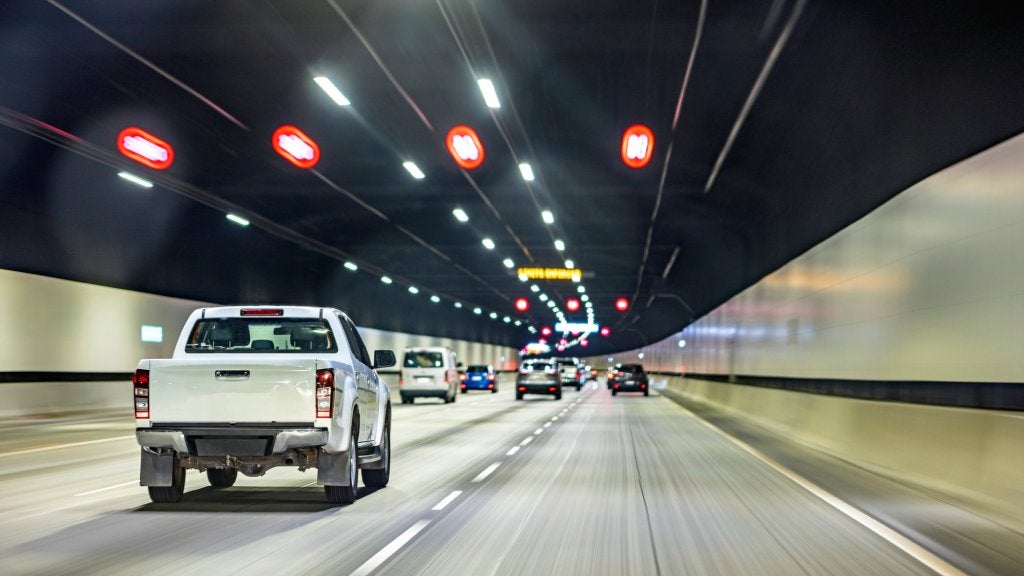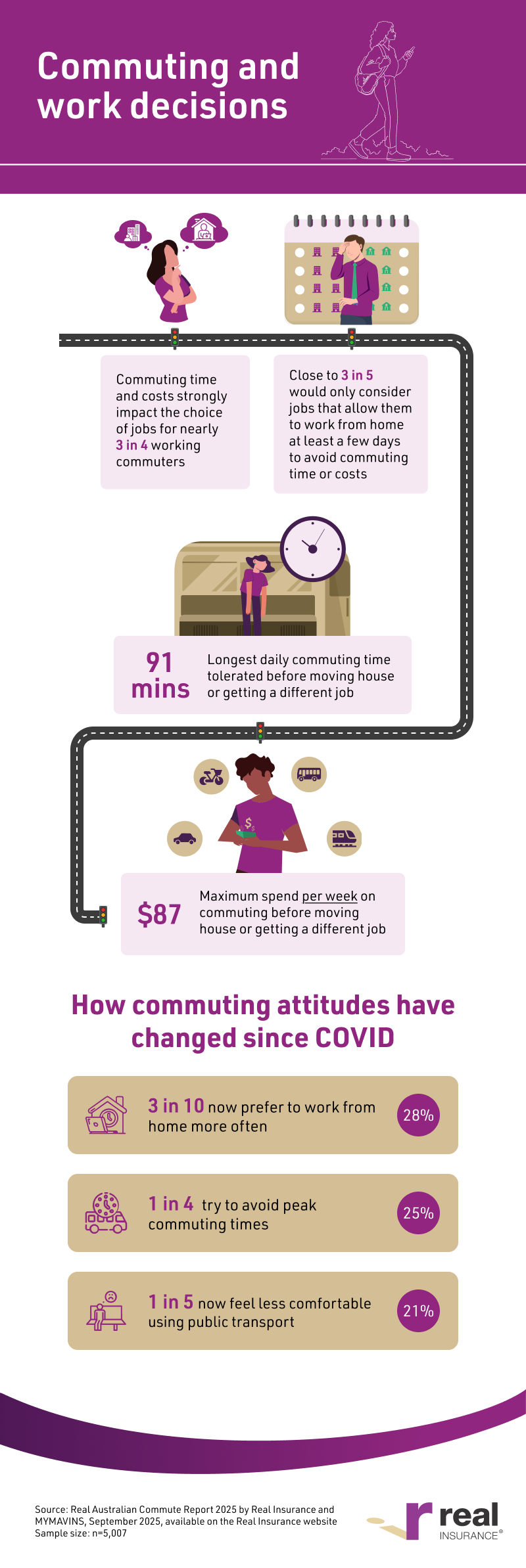The Real Commute Report 2025

26 Oct 2025
New data from life insurance provider Real Insurance reveals how far Australians travel, what we spend, and how commuting shapes work and wellbeing in 2025. From mode choices and toll avoidance to hybrid work and EV interest, the Real Australian Commute Report 2025 highlights the trade-offs commuters make every week. This report is part of the ongoing Real Insurance Research Series exploring the realities of Australian life. Continuing our research from the 2022 Real Australian Commute Report, our 2025 edition examines how the Aussie commute continues to evolve. Based on a nationally representative survey of 2,000 Australians conducted in August 2025, it uncovers our growing tolerance for longer commutes, top commuting pet peeves, and the impacts of travel on our wallets and wellbeing. Download the full report and see how your trip stacks up.
Key findings
- Australians now travel about 37 km and 63.7 minutes per day on average
- Commute tolerance has risen to 91 minutes one way before moving jobs or house (up from 62 minutes in 2022)
- 64% still drive to work; train usage has climbed to 30% (from 21% in 2022)
- Average daily out-of-pocket spend is $19.10; toll spend has dropped from $8.99 (2022) to $4.80 (2025)
- 71% say rising cost-of-living pressures have impacted commuting expenses; top asks are better roads, cheaper fares, and more frequent public transport
What’s your commute like?
That daily dash to work and back is a huge part of our lives. But how much do we really know about this shared Aussie experience?
For many of us, it’s a familiar ritual that consumes a large part of our day – and our latest Real Australian Commute Report 2025 paints a vivid picture of what that looks like across the country. Some things remain unchanged, while other aspects of our daily trek are slowly shifting gears.
The journey: still cruisin’ (mostly!)
So, what does the typical Aussie commute look like in 2025? Private vehicles remain king, with over 3 in 5 (64%) of us still driving solo to work – unchanged since 2022. If you’re singing along to your favourite tunes in the car, you’re far from alone.
Walking (25%) and bus travel (23%) have remained steady too, but train usage has climbed, with 3 in 10 (30%) commuters now hopping on board compared to just over 1 in 5 (21%) in 2022. And while e-bikes and e-scooters may seem everywhere, they still make up a small slice of the commute at just 6% (split evenly between electric and non-electric).
The cost: how far, how long, how much?
The average Aussie is now travelling around 37 km and spending just over an hour (63.7 minutes) commuting each day. Across a typical three-day commute, that adds up to 166 hours a year – nearly 21 standard eight-hour workdays spent just getting to and from work.
Beyond time and distance, there’s the cost. Daily out-of-pocket spend averages $19.10. While similar to 2022 ($19.90), when adjusted for inflation it’s actually cheaper in real terms. That drop reflects state initiatives like 50c fares in Queensland, half-price fares in Tasmania, capped costs in WA, and fare-free Fridays in the ACT – along with a dip in petrol prices since their 2022 peak.
However, annual vehicle upkeep (rego, insurance, maintenance) has crept up to $2,298. According to ABS 2021 census data, the average Australian household has 1.8 vehicles, with over half owning two or more – meaning these costs quickly multiply.

The cost-of-living crunch
It’s no surprise the rising cost of living is front of mind. Over 7 in 10 (71%) Australians say commuting expenses are being impacted, and 62% describe commuting as expensive or very expensive.
So how are we saving? Finding the best fuel deals remains our top tactic (44%), followed by public transport use (33%). A newer habit is toll avoidance, with 30% of commuters now actively steering clear. As a result, daily toll spend has dropped sharply – from $8.99 in 2022 to $4.80 in 2025. Every cent really does count.
Passing time: from podcasts to pet peeves
Whether you’re on public transport or behind the wheel, every commute comes with habits and frustrations.
On public transport:
- 3 in 4 (75%) use trip planner apps
- 9 in 10 (90%) keep themselves entertained
- 7 in 10 (71%) try to stay productive
- Nearly all (92%) stay alert to their surroundings
The idea of a “commute buddy” divides opinion – close to half (48%) are in favour, while just over half (52%) prefer to go solo.
For drivers, nearly half (46%) admit they judge how annoying another motorist will be based on their vehicle. Brands most often named include BMW, Ford, Tesla, and Holden Commodore, with utes and large SUVs/4WDs called out as common culprits.
Physical and emotional toll: what annoys us most?
Public transport frustrations are led by delays or cancellations (66%), followed by crowded carriages (59%), other passengers’ behaviour (52%), and unpleasant smells (52%).
For private commuters, traffic congestion is the top headache (59%), with inconsiderate (51%) and aggressive drivers (49%) close behind. Roadworks, distracted drivers, and fuel/toll costs also rank high.
Ride-sharing: the new normal?
Ride-sharing services like Uber are firmly embedded in commuting life. Over 7 in 10 (72%) Australians used one in the past year, up from 64% in 2022. Nearly 1 in 3 (32%) say they’re using ride-share more often than before 2023.
But carpooling features (like Uber Pool) aren’t catching on – nearly 3 in 5 (59%) never use them. It seems many of us still prefer our own space.
Work location: the commute factor in careers
Here’s a big one: Aussies are now willing to tolerate a daily commute of up to 91 minutes before considering moving or changing jobs – a big jump from 62 minutes in 2022. Housing affordability pressures and hybrid work patterns likely play a role.
While 42% say their commuting attitudes haven’t changed since COVID, nearly 3 in 10 (28%) now prefer to work from home more often. If forced back full-time, 66% of hybrid workers would be concerned about the costs, and 64% would consider looking for another job.

The environment: going green on the go
Nearly half (48%) of Australians either own or are considering an electric or hybrid car. The top motivator is low running costs (74%), followed by environmental benefits.
But barriers remain: 39% say affordability is the biggest obstacle, 36% lack charging facilities, and 35% question whether EVs really make a difference.
E-bikes and e-scooters are viewed positively by over 2 in 5 (40%), though uptake remains modest.
Changes in government: what we want
It’s clear commuting isn’t just about getting from A to B. It shapes our wallets, wellbeing, and even where we choose to live.
So what’s on our commuting wish list?
- Improved road infrastructure to ease congestion (45%)
- Better public transport coverage and frequency (42%)
- More affordable fares (40%)
But commuters’ demands don’t end there. Many also want reduced tolls (33%), direct subsidies or tax breaks (30%), and stronger investment in infrastructure that supports flexible work and active transport – from remote work hubs to cycling paths and safer e-scooter regulations.
How do we change our perception of public transport?
We asked Dr Páraic Carroll, Lecturer in Transport Planning at the University of Melbourne, for his top tips.
What would our cities look like if we valued comfort, community, and wellbeing on public transport as much as punctuality and efficiency?
According to the Real Australian Commute Report 2025, most Australians still drive to work – nearly two-thirds (64%) – while only about a third use trains or buses, which is no real surprise. Yet the survey also reveals what’s holding people back: crowded carriages, delays, and stress are among the top frustrations. If we reimagined public transport to focus not just on speed and punctuality, but also on comfort, community, and wellbeing, taking public transport could become something people look forward to rather than dread.
Methodology
The findings in this article are drawn from the Real Australian Commute Report 2025, which surveyed a nationally representative sample of Australian adults about their commuting habits and attitudes. The survey was conducted online, using demographic stratification to ensure responses reflected Australia’s diverse population by age, gender, and location.

Dr. Páraic Carroll
Dr Páraic Carroll is a Lecturer in Transport Planning at the Melbourne School of Design, the University of Melbourne. His research focuses on creating more equitable and sustainable transport systems through innovative policy and planning solutions. He examines the complex relationships between transport systems and social equity, with particular emphasis on travel behaviour analysis and modelling, rural and regional transport accessibility, transport equity and social inclusion strategies, and sustainable mobility transitions. His work bridges engineering, planning, and policy perspectives to address critical challenges in transport accessibility, particularly for underserved and regional communities.
Download full research report
- Real Commute Report 2025 [PDF]